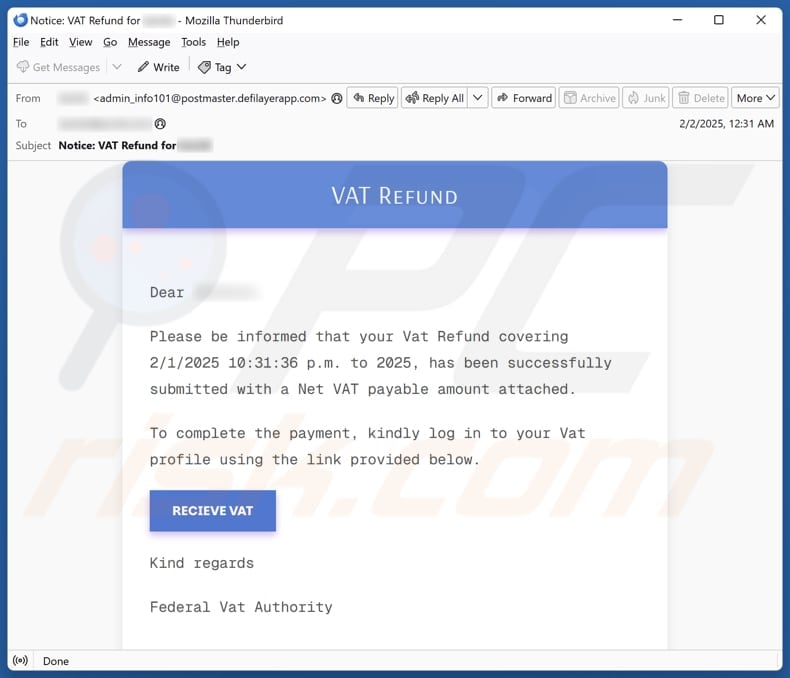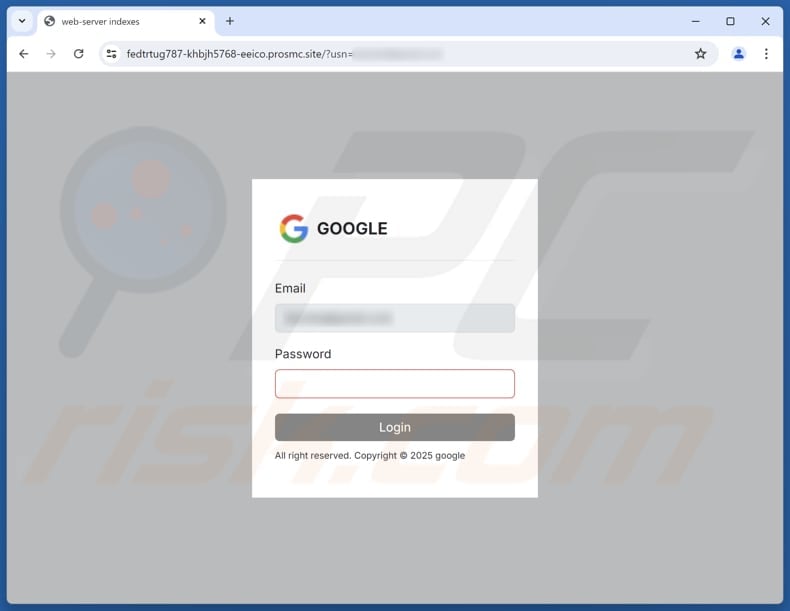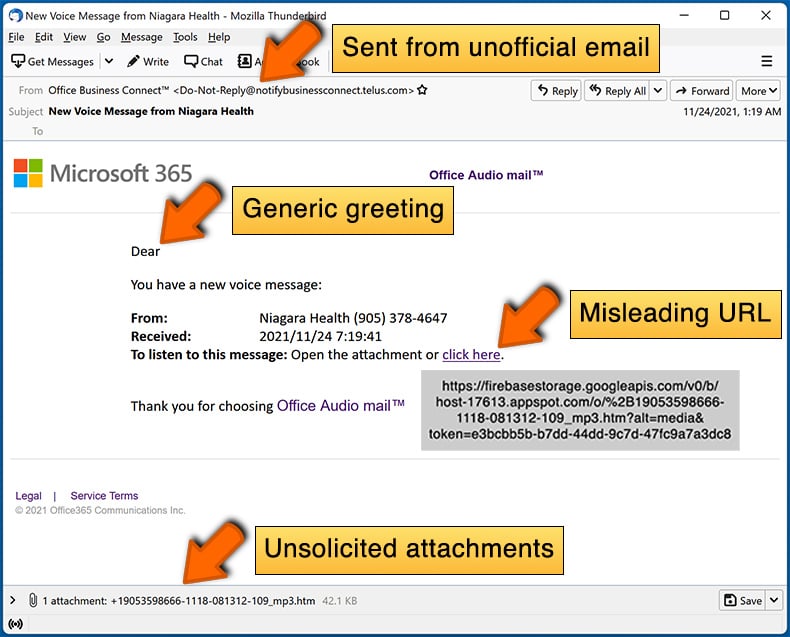How to identify scam emails like "VAT Refund"
Phishing/ScamAlso Known As: VAT Refund phishing email
Get free scan and check if your device is infected.
Remove it nowTo use full-featured product, you have to purchase a license for Combo Cleaner. Seven days free trial available. Combo Cleaner is owned and operated by RCS LT, the parent company of PCRisk.com.
What is "VAT Refund" scam?
Our team has inspected the email and found that it is disguised as a message regarding a VAT (Value Added Tax) refund. It is crafted by scammers who aim to steal personal information from recipients. Emails of this type are classified as phishing emails. They should be ignored to avoid potential consequences.

More about the "VAT Refund" scam email
This phishing email pretends to be from a "Federal VAT Authority" and claims that a VAT refund has been processed for the recipient. It asks the recipient to log into their VAT profile using a provided link (a button labeled "RECIEVE VAT", with a typo) to complete the payment and receive VAT.
Clicking that link opens a fake Google login form designed to extract email addresses and passwords (login credentials) from unsuspecting users. Upon clicking a fake "Login" button, the entered information is automatically transmitted to scammers, who can misuse it for malicious purposes.
If scammers gain access to login credentials, they may attempt to infiltrate accounts such as email, banking, and social media. This could result in unauthorized transactions, identity theft, phishing attacks, malware infections, and more. The stolen information could also be sold on the dark web.
For these reasons, it is important to always scrutinize emails before clicking links or sharing personal information and learn how to identify scam emails.
| Name | VAT Refund Email Scam |
| Threat Type | Phishing, Scam, Social Engineering, Fraud |
| Fake Claim | Aa VAT refund has been processed for the recipient |
| Related Domain |
prosmc[.]site |
| Detection Names (prosmc[.]site) | N/A (VirusTotal) |
| Disguise | Letter from Federal VAT Authority |
| Symptoms | Generic greeting, urgent language, suspicious links, grammatical errors. |
| Distribution methods | Deceptive emails, rogue online pop-up ads, search engine poisoning techniques, misspelled domains. |
| Damage | Loss of sensitive private information, monetary loss, identity theft. |
| Malware Removal (Windows) |
To eliminate possible malware infections, scan your computer with legitimate antivirus software. Our security researchers recommend using Combo Cleaner. Download Combo CleanerTo use full-featured product, you have to purchase a license for Combo Cleaner. 7 days free trial available. Combo Cleaner is owned and operated by RCS LT, the parent company of PCRisk.com. |
Similar scam emails in general
These emails often contain urgent language and pressure the recipient to act quickly. They typically include links that lead to fake login pages designed to steal credentials. These emails may also appear to come from official organizations, companies, or other entities. Sometimes, they can be used to deliver malicious software.
Some examples of phishing emails are "Capital One - Card Purchase Is Under Review", "Update Your Webmail Account Settings", and "One Time Verification".
How do spam campaigns infect computers?
Threat actors use emails to deliver malware by including harmful attachments or links. Opening these attachments, such as MS Office documents, PDFs, executables, or other files, can trigger malware infections. It is important to note that malware may not be able to infiltrate unless additional steps are taken (e.g., macros in malicious MS documents are enabled).
Such emails can also lead to fake websites that automatically download malware or trick users into downloading dangerous software themselves. Overall, deceptive emails are designed to deceive recipients into taking actions that can compromise their security.
How to avoid installation of malware?
Be cautious with suspicious emails, particularly those containing attachments or links. Only download programs from trusted sources like official websites or reputable app stores, and steer clear of sites offering pirated software, keygens, cracking tools, etc. Keep your system and software up to date, and use trusted antivirus and anti-malware programs.
Avoid interacting with pop-ups, ads, or links from unreliable websites, and do not allow notifications from them. If you have already opened malicious attachments, we recommend running a scan with Combo Cleaner Antivirus for Windows to automatically eliminate infiltrated malware.
Text presented in the "VAT Refund" email letter:
Subject:
VAT RefundDear ******,
Please be informed that your Vat Refund covering 2/1/2025 10:31:36 p.m. to 2025, has been successfully submitted with a Net VAT payable amount attached.
To complete the payment, kindly log in to your Vat profile using the link provided below.
Recieve vat
Kind regards
Federal Vat Authority
© 2025 *****.com Company. All rights reserved.
If you no longer wish to receive emails, unsubscribe here.
Phishing website used in this scam:

Instant automatic malware removal:
Manual threat removal might be a lengthy and complicated process that requires advanced IT skills. Combo Cleaner is a professional automatic malware removal tool that is recommended to get rid of malware. Download it by clicking the button below:
DOWNLOAD Combo CleanerBy downloading any software listed on this website you agree to our Privacy Policy and Terms of Use. To use full-featured product, you have to purchase a license for Combo Cleaner. 7 days free trial available. Combo Cleaner is owned and operated by RCS LT, the parent company of PCRisk.com.
Quick menu:
- What is VAT Refund phishing email?
- Types of malicious emails.
- How to spot a malicious email?
- What to do if you fell for an email scam?
Types of malicious emails:
![]() Phishing Emails
Phishing Emails
Most commonly, cybercriminals use deceptive emails to trick Internet users into giving away their sensitive private information, for example, login information for various online services, email accounts, or online banking information.
Such attacks are called phishing. In a phishing attack, cybercriminals usually send an email message with some popular service logo (for example, Microsoft, DHL, Amazon, Netflix), create urgency (wrong shipping address, expired password, etc.), and place a link which they hope their potential victims will click on.
After clicking the link presented in such email message, victims are redirected to a fake website that looks identical or extremely similar to the original one. Victims are then asked to enter their password, credit card details, or some other information that gets stolen by cybercriminals.
![]() Emails with Malicious Attachments
Emails with Malicious Attachments
Another popular attack vector is email spam with malicious attachments that infect users' computers with malware. Malicious attachments usually carry trojans that are capable of stealing passwords, banking information, and other sensitive information.
In such attacks, cybercriminals' main goal is to trick their potential victims into opening an infected email attachment. To achieve this goal, email messages usually talk about recently received invoices, faxes, or voice messages.
If a potential victim falls for the lure and opens the attachment, their computers get infected, and cybercriminals can collect a lot of sensitive information.
While it's a more complicated method to steal personal information (spam filters and antivirus programs usually detect such attempts), if successful, cybercriminals can get a much wider array of data and can collect information for a long period of time.
![]() Sextortion Emails
Sextortion Emails
This is a type of phishing. In this case, users receive an email claiming that a cybercriminal could access the webcam of the potential victim and has a video recording of one's masturbation.
To get rid of the video, victims are asked to pay a ransom (usually using Bitcoin or another cryptocurrency). Nevertheless, all of these claims are false - users who receive such emails should ignore and delete them.
How to spot a malicious email?
While cyber criminals try to make their lure emails look trustworthy, here are some things that you should look for when trying to spot a phishing email:
- Check the sender's ("from") email address: Hover your mouse over the "from" address and check if it's legitimate. For example, if you received an email from Microsoft, be sure to check if the email address is @microsoft.com and not something suspicious like @m1crosoft.com, @microsfot.com, @account-security-noreply.com, etc.
- Check for generic greetings: If the greeting in the email is "Dear user", "Dear @youremail.com", "Dear valued customer", this should raise suspiciousness. Most commonly, companies call you by your name. Lack of this information could signal a phishing attempt.
- Check the links in the email: Hover your mouse over the link presented in the email, if the link that appears seems suspicious, don't click it. For example, if you received an email from Microsoft and the link in the email shows that it will go to firebasestorage.googleapis.com/v0... you shouldn't trust it. It's best not to click any links in the emails but to visit the company website that sent you the email in the first place.
- Don't blindly trust email attachments: Most commonly, legitimate companies will ask you to log in to their website and to view any documents there; if you received an email with an attachment, it's a good idea to scan it with an antivirus application. Infected email attachments are a common attack vector used by cybercriminals.
To minimise the risk of opening phishing and malicious emails we recommend using Combo Cleaner Antivirus for Windows.
Example of a spam email:

What to do if you fell for an email scam?
- If you clicked on a link in a phishing email and entered your password - be sure to change your password as soon as possible. Usually, cybercriminals collect stolen credentials and then sell them to other groups that use them for malicious purposes. If you change your password in a timely manner, there's a chance that criminals won't have enough time to do any damage.
- If you entered your credit card information - contact your bank as soon as possible and explain the situation. There's a good chance that you will need to cancel your compromised credit card and get a new one.
- If you see any signs of identity theft - you should immediately contact the Federal Trade Commission. This institution will collect information about your situation and create a personal recovery plan.
- If you opened a malicious attachment - your computer is probably infected, you should scan it with a reputable antivirus application. For this purpose, we recommend using Combo Cleaner Antivirus for Windows.
- Help other Internet users - report phishing emails to Anti-Phishing Working Group, FBI’s Internet Crime Complaint Center, National Fraud Information Center and U.S. Department of Justice.
Frequently Asked Questions (FAQ)
Why did I receive this email?
These emails are often generic and not personalized. Scammers usually send them in bulk, using email addresses obtained from data breaches or using other methods.
I have provided my personal information when tricked by this email, what should I do?
If you have disclosed personal information in a phishing scam, immediately change your passwords. Notify your bank, email provider, or any other affected services to report the breach and secure your accounts.
I have downloaded and opened a malicious file attached to this email, is my computer infected?
If the file was an executable, your system is probably compromised. If it was a document file like a PDF or DOC, you might have avoided a malware infection. It depends on the file type (not all infected files can inject malware simply after being opened).
I have read the email but did not open the attachment, is my computer infected?
Opening an email is generally safe, but clicking on links or opening attachments can trigger malware infections.
Will Combo Cleaner remove malware infections that were present in email attachment?
Combo Cleaner can detect and remove most known malware, but advanced threats may be deeply hidden in your system. For this reason, running a full system scan is required for thorough protection (detection and removal).
Share:

Tomas Meskauskas
Expert security researcher, professional malware analyst
I am passionate about computer security and technology. I have an experience of over 10 years working in various companies related to computer technical issue solving and Internet security. I have been working as an author and editor for pcrisk.com since 2010. Follow me on Twitter and LinkedIn to stay informed about the latest online security threats.
PCrisk security portal is brought by a company RCS LT.
Joined forces of security researchers help educate computer users about the latest online security threats. More information about the company RCS LT.
Our malware removal guides are free. However, if you want to support us you can send us a donation.
DonatePCrisk security portal is brought by a company RCS LT.
Joined forces of security researchers help educate computer users about the latest online security threats. More information about the company RCS LT.
Our malware removal guides are free. However, if you want to support us you can send us a donation.
Donate
▼ Show Discussion